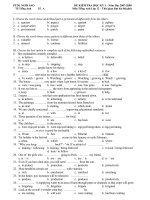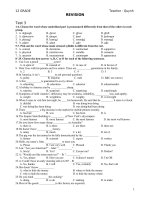Unit3- 12CB+test yourself
Bạn đang xem bản rút gọn của tài liệu. Xem và tải ngay bản đầy đủ của tài liệu tại đây (109.46 KB, 12 trang )
Date of preparing:……/..../200…..
Date of teaching:……/ …./200…..
Class:……………….
Unit 3
WAYS OF SOCIALIZING
---------------oOo-------------
Period N
o
11- Lesson 1: Reading
I. Objectives:
1. Educational aim: Students can:
- Develop such reading micro-skills as guessing meaning from context
- Use the information they have read to answer the questions
2. Knowledge:
- General knowledge: Students could understand and use the new words through speaking, asking
and answering
- New words: Words relate to ways of socialising
3. Skills:
-Reading for general or specific information
-Guessing meaning from context
II. Method:
- Integrated, mainly communicative
III. Teaching aids:
- Some photos of ways of socialising and some information about them, board, tape, cassette
player, chalks, textbook and notebook.
IV. Procedures:
Time
5’
5’
5’
10’
10’
Teacher’s activities
- ask Ss to match the
verbs in A with its
object in B.
- call on some Ss to
answer in front of the
class.
- give suggested
answers.
- ask Ss to look at the
pictures on page 30 and
answer the questions.
- call on some Ss to
answer in front of the
class.
- give suggested
answers.
- read word by word.
- ask Ss to repeat in
chorus and individual
and write them on the
blackboard.
- say some words in
English and ask Ss to
speak them out in
Vietnamese.
- ask Ss to read the
passage in silence and
do task 2.
- ask Ss to compare the
answer with a partner.
- call on some Ss to
answer in front of the
class.
- comment and give
correct answer.
- ask Ss to work in pairs
to ask and answer
Content
A. Warm- up: -Match the verbs in A with
its object in B:
A
1. to attract
2. to raise
3. to clap
4. to get
B
one’s hand(s)
one’s attention
Answers:
to attract one’s attention
to get one’s attention
to raise one’s hand(s)
to clap one’s hand(s)
- Look at the pictures on
page 30 and answer the questions
Answers:
1. - They are shaking hands.
- They are raising hands to wave goodbye.
……………………………….
B. Pre- reading
I. Vocabulary:
- to attract someone’s attention [ə'trækt
'sʌmwʌn’z ə'ten∫n]: thu hót sù chó ý cña ai
- verbal (adj) ['və:bl]: b»ng lêi, h÷u ng«n
- non- verbal (adj) [,nɔn-'və:bl ]: kh«ng b»ng
lêi, phi ng«n
- signal (n) ['signəl]: tÝn hiÖu
- appropriate (adj) [ə'proupriət]: thÝch ®¸ng
- to nod (v) [nɔd]: gËt ®Çu
- informality (n) [,infɔ:'mæliti]: kh«ng h×nh
thøc
- to approach (v) [ə'prout∫]: ®Õn gÇn, l¹i
gÇn
II. Checking vocabulary: Task 1
C. While- reading
I. Task 2:
Answer:
A. Attracting Attention : Non- verbal Cues
II. Task 3:
Students’ activities
- do the task
individually.
- some Ss answer in
front of the class.
- do the task in pairs.
- some Ss answer in
front of the class.
- listen carefully
- repeat after the
teacher in chorus and
individual and write
down.
- do the task
individually.
- read the passage in
silence and do task 2.
- compare the answer
with a partner.
- some Ss answer in
front of the class.
- work in pairs to ask
and answer about the
Date of preparing:……/..../200…..
Date of teaching:……/ …./200…..
Class:………………..
Unit 3
WAYS OF SOCIALIZING
---------------oOo-------------
Period N
o
12- Lesson 2: Speaking
I. Objectives:
1. Educational aim: Students should know
- Use appropriate language to practise giving and responding to compliments in different situations
- Use appropriate language to talk about other ways of communication
2. Knowledge:
- General knowledge: Students can talk about other ways of communication
- Language: Words to speak about ways of communication
3. Skills:
-Ask and answer the information about ways of communication
II. Method:
- Integrated, mainly communicative
III. Teaching aids:
- Photos of some famous persons or some real information about ways of communication
IV. Procedures:
Time
5’
5’
2’
10’
Teacher’s activities
- ask Ss to rearrange
words to make
meaningful sentences.
- give suggested
answers.
- lead in the new
lesson.
- read word by word.
- ask Ss to repeat in
chorus and individual
and write them on the
blackboard.
- read the English
words and tell Ss to say
the Vietnamese
equivalent.
- elicit compliment
formulas, useful
expressions used to
compliment and
responses to the
compliments.
- comment and give
suggested answers.
Content
A. Warm- up: Rearrange words to make
meaningful sentences.
1. your/ excellent/ thought/ was/ tennis
game/ today/ I/./
2. jacket/ have/ a/ beautiful/ you/ very/
really/ !/
3. shoes/ you/ that’s/ wearing/ nice/ of/ are/
a/ pair
Answers:
1. I thought your tennis game was
excellent today.
2. You really have a very beautiful jacket!
3. That’s a nice pair of shoes you are
wearing.
Lead- in: Those sentences are compliments.
Today, we will practice giving and
responding to compliments in different
situations.
B. Pre- speaking
I. Vocabulary
- compliment (n) ['kɔmplimənt]: khen ngîi
- terrific (adj) [tə'rifik]: tuyÖt vêi
- decent (adj) ['di:snt]: ®øng ®¾n, chØnh tÒ,
nghiªm tóc
- to handle (v) ['hændl]: vÊn tãc lªn
- to kid (v) [kid]: nãi ®ïa
- tune (n) [tju:n]: giai ®iÖu
- to be in/ out of tune (with sb/ st): hoµ hîp/
kh«ng hoµ hîp víi ai
II. Checking vocabulary
III. Compliment formulas, useful
expressions used to compliment and
responses to the compliment s: Task 1
*The great majority of compliments
included the most common five adjectives
(nice, good, beautiful, pretty and great) and
two verbs (love and like)
* Some useful expressions used to
compliment
- You have…………..
- How + Adjective……..!
- What (a/ an) Noun…....!
- Congratulations! You………..
…................
* Some responses to the compliments:
- Thank you for your compliments. I’m glad
you like it.
- Thanks. It’s all very well for you to say so.
- Your compliment is encouraging.
Students’ activities
- do the task
individually.
- listen carefully.
- listen carefully
- repeat after the
teacher in chorus and
individual and write
down.
- do the task
individually.
- speak out.
Date of preparing:……/..../200…..
Date of teaching:……/ …./200…..
Class:………………..
Unit 3
WAYS OF SOCIALIZING
---------------oOo-------------
Period N
o
13- Lesson 3: Listening
I. Objectives:
1. Educational aim:
- Students should know to develop such listening micro-skills as intensive listening for specific
information
2. Knowledge:
- General knowledge: Students know how to give information after listening
- New words: Words related to ways of socialsing
3. Skills:
- Listening for general or specific information
- Comprehension questions
II. Method:
- Integrated, mainly communicative
III. Teaching aids:
- Some pictures of persons or some real information about them, board, tape, cassette player, chalks,
textbook and notebook.
IV. Procedures:









